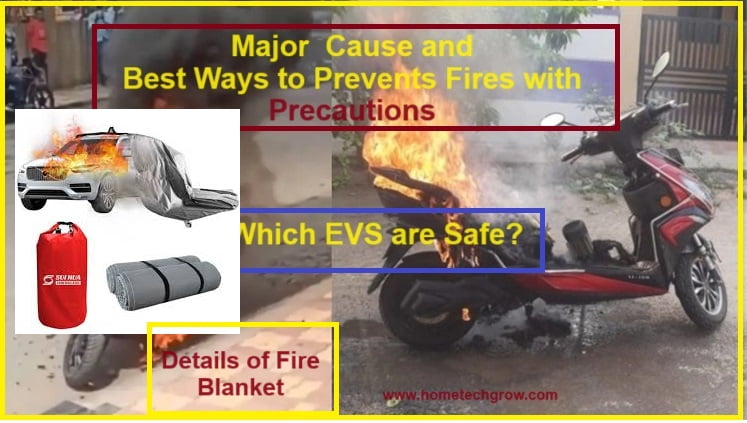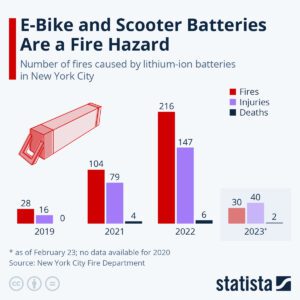Major Causes of Fire from Battery in Electric Vehicles
- Around 95% of batteries in EV fires are classified as ignition fires, producing jet-like directional flames.
- The rest of the 5% involves a vapor cloud explosion.
- Several factors can cause a battery to catch fire, including physical damage from accidents, manufacturing defects, battery faults, workshop repairs, arson, external fires, or overheating.
- Fires in electric vehicles (EVs) can be caused by several factors, including the following factors.
- Addressing these potential causes requires a comprehensive approach, including robust battery design, effective thermal management, quality control during manufacturing, adherence to safety standards, proper maintenance and monitoring, and user education on safe handling and charging practices.
List of major causes of fires
- Overheating of Batteries
- Internal Short Circuits: Manufacturing defects, physical damage, or internal faults within the battery cells can cause short circuits, leading to rapid heat generation and potential fire hazards
- External Damage: Accidents, collisions, or impacts that damage the battery pack or its protective casing can expose the cells to external elements, increasing the risk of short circuits and fires
- Improper Charging: Using non-compatible or faulty charging equipment, improper charging protocols, or charging in extreme conditions (e.g., high temperatures) can compromise battery safety and lead to fires.
- Cell Aging and Degradation: As batteries age, their internal components may degrade, leading to increased internal resistance, reduced capacity, and potential susceptibility to thermal events that can trigger fires
- Electrical System Faults: Malfunctions or faults in the electrical systems of EVs, such as faulty wiring, connectors, or control systems, can cause electrical arcing, overheating, and fire risks.
- Software or Firmware Issues: Bugs, glitches, or errors in the battery management system (BMS) software or firmware can lead to incorrect monitoring, control, or regulation of battery parameters, potentially causing hazardous conditions.
- External Factors: Environmental conditions like extreme temperatures, exposure to moisture or chemicals, or improper storage and handling of batteries can contribute to fire risks.
- Inadequate Ventilation: Poor ventilation or airflow around the battery pack can lead to heat buildup, especially during high-demand operations like fast charging or heavy use.
- Battery Abuse: Mishandling of batteries, such as physical abuse, puncturing, or exposing them to extreme conditions beyond their specifications, can compromise their integrity and safety.
Battery Overheating
-
- Overcharging, fast charging, or prolonged use at high temperatures can lead to overheating of the battery cells, which may result in a thermal runaway and fire.
- Batteries in electric vehicles (EVs) can overheat due to several reasons, leading to potential fire hazards. Here are some of the primary causes and preventive measures:
High Ambient Temperatures:
- Extreme environmental conditions, especially high temperatures, can cause the battery cells to overheat.
- This can occur during prolonged exposure to hot climates or when the vehicle is parked in direct sunlight for extended periods.
- Preventive Measures:
- Implementing effective thermal management systems, such as liquid cooling or active air cooling, helps regulate the battery temperature.
- Insulating the battery pack and using reflective materials on the exterior can also reduce heat absorption from sunlight.
Fast Charging
- Rapid charging, especially using high-power chargers, can generate heat in the battery cells due to the rapid influx of energy.
- If not managed properly, this can lead to overheating and potential fire risks.
- Preventive Measures
-
- Incorporating intelligent charging algorithms in the battery management system (BMS) to optimize charging rates based on battery temperature and state of charge (SoC) can prevent excessive heat buildup.
- Additionally, providing sufficient cooling during fast charging sessions mitigates overheating risks.

Overcharging:
- Charging the battery beyond its recommended voltage or exceeding its capacity can cause internal resistance and heat generation, leading to thermal runaway and fire hazards.
- Preventive Measures: Implementing voltage and current monitoring within the BMS to prevent overcharging, along with using chargers that comply with safety standards and have built-in protections against overcharge events.
- Poor Thermal Management: Inadequate cooling or ventilation around the battery pack can lead to heat buildup during normal operation, especially under high-demand scenarios like heavy acceleration or sustained high-speed driving.
- Preventive Measures: Design the vehicle with efficient cooling systems, such as liquid-cooled battery packs or active thermal management systems, to dissipate heat effectively. Ensuring proper airflow and ventilation within the battery compartment also helps maintain optimal operating temperatures.
- Battery Defects or Damage: Manufacturing defects, cell damage, or degradation over time can compromise the integrity of battery cells, leading to increased heat generation and potential fire risks.
- Preventive Measures: Implementing stringent quality control measures during battery manufacturing, conducting regular inspections and testing for cell integrity, and incorporating safety features like thermal sensors and shutdown mechanisms in the battery pack.
- Abnormal Operating Conditions: Unforeseen events such as electrical faults, system malfunctions, or external influences like accidents or impacts can cause abnormal operating conditions that lead to battery overheating.
- Preventive Measures:
- Implementing robust safety protocols and emergency shutdown mechanisms within the BMS to respond to abnormal conditions promptly.
- Conducting thorough risk assessments and simulations to identify potential failure scenarios and design systems to mitigate their impact.
- Preventive Measures:

Methods to Prevent Fires from Battery
- Preventing fires in electric vehicles (EVs) involves a combination of design, technology, and operational practices. Here are some key strategies:
- Battery Management Systems (BMS):
- BMS is crucial for monitoring and managing the health of the battery pack.
- It regulates charging and discharging, controls temperature, and ensures cells are operating within safe limits.
- Thermal Management:
- EVs use sophisticated thermal management systems to regulate battery temperature.
- This includes liquid cooling or air cooling systems to prevent overheating.
- Cell Design:
- Advancements in cell design include safety features such as ceramic-coated separators and shutdown mechanisms to prevent thermal runaway.
- Battery Pack Design:
- The physical design of battery packs includes features like firewalls between cells, crash barriers, and materials that resist heat and fire.
- Quality Control: Stringent quality control measures during manufacturing are essential to ensure the integrity of battery cells and packs.
- Testing and Certification: Batteries undergo rigorous testing and certification to meet safety standards like UN ECE Regulation 100 and ISO 26262.
- Education and Training: Training for EV owners, emergency responders, and maintenance personnel is critical for handling EVs safely and responding to incidents effectively.
- Monitoring and Maintenance: Regular monitoring of battery health, software updates, and maintenance checks can identify potential issues before they escalate.
- Emergency Response Planning: Establishing protocols for responding to battery-related incidents, including firefighting procedures specific to EVs, is crucial.
- Regulations and Standards: Governments and industry bodies play a vital role in setting safety standards, regulations, and guidelines for EVs and their components.
Implementing these strategies collectively helps mitigate the risk of fires in EV batteries and ensures the safe operation of electric vehicles.

Fire Proof Banket for EV
- Fireproof blankets for electric vehicles (EVs) are designed to provide an additional layer of protection against battery fires or thermal events.
- These blankets are made from fire-resistant materials and are intended to contain and suppress fires, preventing them from spreading or causing further damage. Here are some key features and considerations for fireproof blankets used in EVs:
- High-temperature Resistance:
- Fireproof blankets are typically made from materials that can withstand high temperatures up to 1100 °C, such as fiberglass, aramid fibers (e.g., Nomex), or ceramic fabrics.
- These materials have excellent thermal insulation properties and can withstand direct exposure to flames and heat.

Fireproof Blanket Kit for EV
- Heat Reflectivity:
- The blankets may have a reflective outer layer that helps deflect radiant heat
- It prevents it from reaching the interior components of the vehicle or nearby objects.
- Fire Containment:
- The primary purpose of a fireproof blanket is to contain fires and thermal events within a specific area, such as the battery compartment or engine bay of an EV.
- This containment helps prevent the spread of flames and reduces the risk of secondary fires or damage to other vehicle components.
- Flexible and Durable:
- Fireproof blankets need to be flexible and adaptable to fit different areas within the vehicle, including irregular shapes or confined spaces.
- They should also be durable enough to withstand handling during emergencies.
- Quick Deployment: In the event of a fire or thermal incident, the fireproof blanket should be easy to deploy quickly. This may involve securing the blanket using fasteners, straps, or hooks to ensure proper coverage and containment.
- Chemical Resistance:
- Fireproof blankets may also have chemical resistance properties to protect against exposure to fluids or substances that could exacerbate a fire or compromise the integrity of the blanket.
- Certifications and Standards:
- Manufacturers of fireproof blankets often adhere to industry standards and certifications for fire safety and performance.
- These standards may include compliance with regulations such as NFPA 701 (National Fire Protection Association) for flame resistance.
- Maintenance and Reusability:
- Fireproof blankets should be designed for easy maintenance and potential reuse after deployment.
- This may involve cleaning procedures to remove contaminants or debris accumulated during use.

Fire proof Blanket for EV cars
- Compatibility:
- Fireproof blankets should be compatible with the specific make and model of the EV, considering factors such as size, shape, and accessibility of the areas they are intended to cover.
Summary
- By addressing these potential causes and implementing preventive measures, manufacturers can significantly reduce the risk of battery overheating and fires in electric vehicles. Ongoing research and development in battery technology, safety systems, and thermal management continue to improve the overall safety and reliability of EVs.
- Fireproof blankets are part of a comprehensive approach to EV safety, which also includes robust battery management systems, thermal management systems, emergency response protocols, and ongoing training for personnel.
- Integrating these safety measures helps mitigate risks and enhance the overall safety of electric vehicles



